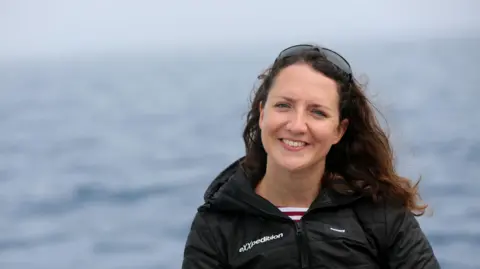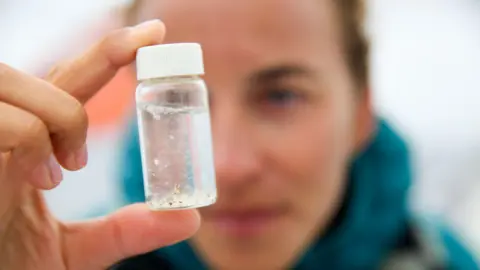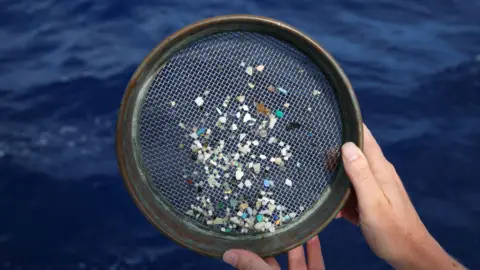Zac Sherratt,
BBC News, South East


Eleanor Church/Lark Rise Pictures
Sally Earthrowl is a geography teacher at Ewell Castle School
A geography teacher from Surrey said she was shocked to see plastic floating on the water “like confetti” when she sailed across the North Pacific Gyre.
Sally Earthrowl, from Byfleet, joined the first leg of the X Trillion expedition in 2018, sailing through what is thought to be the patch of world ocean most densely populated with plastic.
“You really are in one of the most remote places in the planet, yet over the side of the boat you see a stream of plastic waste,” Ms Earthrowl told BBC Radio Surrey.
A documentary of the all-female crew's journey through the area dubbed "the Great Pacific Garbage Patch" will premiere at Curzon Soho, in London, on Thursday.
Sally Earthrowl is a geography teacher at Ewell Castle School
A geography teacher from Surrey said she was shocked to see plastic floating on the water “like confetti” when she sailed across the North Pacific Gyre.
Sally Earthrowl, from Byfleet, joined the first leg of the X Trillion expedition in 2018, sailing through what is thought to be the patch of world ocean most densely populated with plastic.
“You really are in one of the most remote places in the planet, yet over the side of the boat you see a stream of plastic waste,” Ms Earthrowl told BBC Radio Surrey.
A documentary of the all-female crew's journey through the area dubbed "the Great Pacific Garbage Patch" will premiere at Curzon Soho, in London, on Thursday.

Eleanor Church/Lark Rise Pictures
Ms Earthrowl said she was shocked to see the quantity of plastics in water samples take from the ocean
Ms Earthrowl said she was inspired to join X Trillion after watching “piles of plastic making their way to the ocean” when she was teaching in Indonesia during monsoon season.
She said plastic waste gathers together in five parts of the world’s oceans due to surface currents.
The expedition, where 14 women covered 3,000 miles from Hawaii to Vancouver then onto Seattle, aimed to help people understand the true scale of the problem.
The crew dragged a fine-mesh net, about 60cm (23.6in) wide, through the water for one nautical mile.
“We were picking up hundreds of bits of microplastics. They are smaller than your little finger nail. The bigger plastic items fragment into hundreds of smaller pieces. It’s like confetti across the water,” said Ms Earthrowl.
Ms Earthrowl said she was inspired to join X Trillion after watching “piles of plastic making their way to the ocean” when she was teaching in Indonesia during monsoon season.
She said plastic waste gathers together in five parts of the world’s oceans due to surface currents.
The expedition, where 14 women covered 3,000 miles from Hawaii to Vancouver then onto Seattle, aimed to help people understand the true scale of the problem.
The crew dragged a fine-mesh net, about 60cm (23.6in) wide, through the water for one nautical mile.
“We were picking up hundreds of bits of microplastics. They are smaller than your little finger nail. The bigger plastic items fragment into hundreds of smaller pieces. It’s like confetti across the water,” said Ms Earthrowl.

Eleanor Church/X Trillion Film
Microplastic samples in a sieve collected from the trawl in the Great Pacific Garbage Patch
It took three weeks for the crew to sail from Hawaii to Vancouver, during which time they saw just three other boats.
Eleanor Church, the director of the X Trillion film, said: “We were a crew of women with different skills, goals and motivations, brought together to witness and record the true extent of the plastic pollution crisis – with a focus on micro plastics and their toxic impact on female bodies in particular.
“We all emerged transformed by the experience and are committed to telling the story of what we witnessed and working to find solutions.
“The film is about this global crisis, but more than that it highlights the crucial role women play in helping to change systems and find solutions to the big problems facing humanity.”
Microplastic samples in a sieve collected from the trawl in the Great Pacific Garbage Patch
It took three weeks for the crew to sail from Hawaii to Vancouver, during which time they saw just three other boats.
Eleanor Church, the director of the X Trillion film, said: “We were a crew of women with different skills, goals and motivations, brought together to witness and record the true extent of the plastic pollution crisis – with a focus on micro plastics and their toxic impact on female bodies in particular.
“We all emerged transformed by the experience and are committed to telling the story of what we witnessed and working to find solutions.
“The film is about this global crisis, but more than that it highlights the crucial role women play in helping to change systems and find solutions to the big problems facing humanity.”
No comments:
Post a Comment